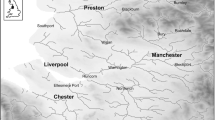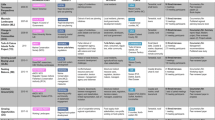Abstract
Collaborative efforts are increasingly being used to address complex environmental problems, both in the United States and abroad. This is especially true in the growing field of collaborative watershed management, where diverse stakeholders work together to develop and advance water-quality goals. Active citizen participation is viewed as a key component, yet groups often struggle to attract and maintain citizen engagement. This study examined citizen participation behavior in collaborative watershed partnerships by way of a written survey administered to citizen members of 12 collaborative watershed groups in Ohio. Results for the determination of who joins such groups were consistent with the dominant-status model of participation because group members were not demographically representative of the broader community. The dominant-status model, however, does not explain which members are more likely to actively participate in group activities. Instead, individual characteristics, including political activity, knowledge, and comfort in sharing opinions with others, were positively correlated with active participation. In addition, group characteristics, including government-based membership, rural location, perceptions of open communication, perceptions that the group has enough technical support to accomplish its goals, and perceived homogeneity of participant opinions, were positively correlated with active participation. Overall, many group members did not actively participate in group activities.
Similar content being viewed by others
References
Abel TD, Stephan M (2000) The limits of civic environmentalism. American Behavioral Scientist 44(4):614–628
Armstrong JS, Overton TS (1977) Estimating nonresponse bias in mail surveys. Journal of Marketing Research 14:396–402
Babchuck N, Booth A (1969) Voluntary association membership: a longitudinal analysis. American Sociological Review 34:31–45
Beierle TC, Cayford J (2002) Democracy in practice: public participation in environmental decisions. Resources for the Future Press, Washington, DC
Blomquist W, Schlager E (2005) The political pitfalls of integrated watershed management. Society and Natural Resources 18(2):101–117
Brady DJ (1996) The watershed protection approach. Water Science Technology 33(4–5):17–21
Byron I, Curtis A (2002) Maintaining volunteer commitment to local watershed initiatives. Environmental Management 30(1):59–67
Carr D, Selin S, Schuett M (1998) Managing public forests: understanding the role of collaborative planning. Environmental Management 22(5):767–776
Chess C, Hance BJ, Gibson G (2000) Adaptive participation in watershed management. Journal of Soil and Water Conservation 3Quarter:248–252
Claibourn MP, Martin PS (2000) Trusting and joining? An empirical test of the reciprocal nature of social capital. Political Behavior 22(4):267–291
Clary EG, Snyder M (1999) The motivations to volunteer: theoretical and practical considerations. Current Directions in Psychological Science 8:156–159
Cortner HJ, Moote MA (1999) The politics of ecosystem management. Island Press, Washington, DC
De Jongh P, Captain S (1999) Our common journey: a pioneering approach to cooperative environmental management. Zed Books, London, UK
Diduck A, Sinclair AJ (2002) Public involvement in environmental assessment: the case of the nonparticipant. Environmental Management 29(4):578–588
Dillman DA (2000) Mail and Internet surveys: the tailored design method. Wiley, New York, NY
Duram LA, Brown KG (1999) Assessing public participation in U.S. watershed planning initiatives. Society and Natural Resources 12:455–467
Filion FL (1975) Estimating bias due to nonresponse in mail surveys. Public Opinion Quarterly 39(4):482–492
Heidrich KW (1990) Volunteer life-styles: market segmentation based on volunteers’ role choices. Nonprofit and Voluntary Section Quarterly 19(1):21–31
King G, Keohane R, Verba S (1994) Designing social inquiry. Princeton University Press, Princeton, MA
Kitts KA (1999) “Not in our backyard”: solidarity, social networks, and the ecology of environmental mobilization. Sociological Inquiry 69:551–574
Koontz TM (2002) Federalism in the forest: national versus state natural resource policy. American Governance and Policy Series. Georgetown University Press, Washington, DC
Koontz TM, Johnson EM (2004) One size does not fit all: matching breadth of citizen participation to watershed group accomplishments. Policy Sciences 37(2):185–204
Koontz TM, Steelman TA, Carmin J, Korfmacher KS, Moseley C, Thomas CW (2004) Collaborative Environmental management what: roles for government? Resources for the Future Press, Washington, DC
Korfmacher KS (2000) Partnering for ecosystem management of the Darby Creek watershed. American Behavioral Scientist 44(4):548–564.
Lant CL (1999) Introduction: human dimensions of watershed management. Journal of the American Water Resources Association 35(3):483–486
Leach WD, Pelkey NW (2001) Making watershed partnerships work: a review of the empirical literature. Journal of Water Resources Planning and Management 127(6):378–385
Leach WD, Pelkey NW, Sabatier PA (2002) Stakeholder partnerships as collaborative policymaking: evaluation criteria applied to watershed management in California and Washington. Journal of Policy Analysis and Management 21(4):645–670
Manzo LC, Weinstein ND (1987) Behavioral commitment to environmental protection: a study of active and non-active members of the Sierra Club. Environment & Behavior 19(6):673–694
Meadowcroft J (1999) Cooperative management regimes: collaborative problem-solving to implement sustainable development. International Negotiation 4(2):225–254
Moore EA, Koontz TM (2003) A typology of collaborative watershed groups: citizen-based, agency-based, and mixed partnerships. Society and Natural Resources 16(5):451–460
Ohio Watershed Network. Watershed groups in Ohio. The Ohio State University Extension. Available at: http://www.ohiowatersheds.osu.edu/groups/. Accessed: June 13, 2004
Pearce JL (1993) Volunteers: the organizational behavior of unpaid workers. Routledge, London, UK
Perkins KB (1989) Volunteer firefighters in the United States: a descriptive study. Nonprofit and Voluntary Sector Quarterly 18(3):269–277
Sabatier PA, Focht W, Lubell M, Trachtenberg Z, Vedlitz A, Matlock M (eds.) (2005) Swimming upstream: collaborative approaches to watershed management. MIT Press, Cambridge, MA
Samuelson CD, Vedlitz A, Whitten GD, Matlock M, Alston LT, Peterson TR, and others (2005) Citizen participation and representation in collaborative engagement processes. In: Sabatier PA, Focht W, Lubell M, Trachtenberg Z, Vedlitz A, Matlock M (eds.), Swimming upstream: collaborative approaches to watershed management. MIT Press, Cambridge, MA. pp 137–169
Schneider MB (2004) The influence of friends on participation in voluntary associations. Paper presented at the Western Political Science Association Annual Meeting, March 11 to 13, Portland, OR
Shindler B, Neburka J (1997) Public participation in forest planning: eight attributes of success. Journal of Forestry 95(1):17–19
Smith DH (1994) Determinants of voluntary association participation and volunteering: A literature review. Nonprofit and Voluntary Sector Quarterly 23:243–263
Snow D (2001) Coming home: an introduction to collaborative conservation. In: Brick P, Snow D, Van de Wetering S (eds.) Across the great divide: explorations in collaborative conservation and the American West. Island Press, Washington, DC. pp 1–11
Steelman TA, Carmin J (2002) Community based watershed remediation: connecting organizational resources to social and substantive outcomes. In: Rahm D (ed.) Toxic waste and environmental policy in the 21st century United States. McFarland Publishers, Jefferson, NC. pp 145–178
Stephan M (2005) Democracy in our backyards: a study of community involvement in administrative decision making. Environment and Behavior 37(5):662–682
Thomas CW (1999) Linking public agencies with community-based watershed organizations: lessons from California. Policy Studies Journal 27:544–564
United States Census Bureau (2004) American community survey. Available at: http://www.factfinder.census.gov/servlet/ADPTable?_bm=y&-context=adp&-ds_name=ACS_2004_EST_G00_&-tree_id=304&-all_geo_types=N&-_caller=geoselect&-geo_id=04000US39&-format=&-_lang=en. Accessed: November 1, 2007
United States Census Bureau (2000) United States census 2000. Available at: http://www.census.gov/main/www/cen2000.html . Accessed: August 23, 2007
Weber EP (2003) Bringing society back in: grassroots ecosystem management, accountability, and sustainable communities. MIT Press, Cambridge, MA
Webler T, Tuler S, Shockey I, Stern P, Beattie R (2003) Participation by local government officials in watershed management planning. Society and Natural Resources 16:105–121
Wilson J, Musick MA (1998) The contribution of social resources to volunteering. Social Science Quarterly 79:799–814
Wondolleck JM, Yaffee SL (2000) Making collaboration work: lessons from innovation in natural resource management. Island Press, Washington, DC
Yaffee S, Phillips AF, Frentz IC, Hardy PW, Maleki SM, Thorpe BE (1996) Ecosystem management in the United States: an assessment of current experience. Island Press, Washington, DC
Acknowledgments
The authors thank the many watershed group members who contributed their time and perspectives by participating in this study, the watershed group leaders who facilitated data collection and shared insights, and Joseph Arvai and Joseph Bonnell for helpful comments. Funding was provided by the Ohio State University School of Environment and Natural Resources.
Author information
Authors and Affiliations
Corresponding author
Appendix: Selected survey questions
Appendix: Selected survey questions
Rights and permissions
About this article
Cite this article
Koehler, B., Koontz, T.M. Citizen Participation in Collaborative Watershed Partnerships. Environmental Management 41, 143–154 (2008). https://doi.org/10.1007/s00267-007-9040-z
Published:
Issue Date:
DOI: https://doi.org/10.1007/s00267-007-9040-z




